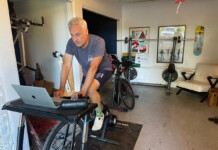Before any bike race, no matter the discipline, you see riders pedaling on trainers, pedaling around the venue; riding hard and riding easy, as they warm up for their race. It is an integral piece of most racers’ pre-race routines. The exact protocol varies but generally follows a similar format; starting with easy riding, ramping the intensity up, and including one or more maximal or submaximal efforts.
The main purpose of a warm-up is just what it sounds like – to literally warm muscles, tendons, ligaments, and joints. This increase in temperature means the hemoglobin in the blood releases oxygen more readily to working muscles. Increased heart rate means there is more blood going to the working muscles. A warm-up also increases the sensitivity of nerve receptors, which speeds up the timing of nervous impulses.
Warm-ups are pretty individual, and as an athlete gains experience, they usually learn how they need to warm up. For the athletes that I coach, I usually provide a warm-up protocol, with the caveat that if they have a warm-up that they know and like, they should use that. It is worth the time and effort to experiment with warm-ups and determine what works for you to feel your best in your event.
Of course, even after you have spent the time to figure out your optimal warm-up routine, keep in mind that what you need to do to warm-up on any given day will vary depending on your level of fatigue coming into the event, the temperature, the duration/intensity of the event, and other factors. Generally, the deeper you are into a training cycle (with more fatigue in your legs), the longer you will need to warm up.
If your race or event is short and very fast (like a short track or criterium race), you should be good and warm on the start line and ready to go fast right away. If you are doing a long race or an event with a neutral start or a road event that will stay together for a while, you can plan on doing less to warm up. Conversely, as you get deeper into a stage race or multi-day event, you usually need less of a warm-up each day, because the body is still relatively primed from the previous day’s efforts.
Because one priority of a warm-up is to physically warm muscle tissues, you need less of a warm-up on a hot day. In fact, if it is warm enough that heat will be a factor in the event, you can do damage by getting too warm prior to the event. It is vital to keep this in mind if your routine is trainer-based. If you don’t have access to a fan or shade, you might be doing more harm than good.
Another important aspect of a warm-up is increasing mental readiness. Just like your muscles, your brain needs tuning and fueling to stay engaged during demanding physical work, and just like your muscles, it needs to be primed for the event to focus.
I often recommend that athletes I coach should do some visualization of their race or event during their warm-up, but typically that also happens organically. When you wake up on race day, nerves are usually high already. When you get on your bike to start warming up, it is natural to start imagining different race scenarios and how you expect or want to feel. This all helps your readiness for the event. These nervous system reactions are a big factor for narrowing your mental focus as well as prepping your body for efforts during a race or hard ride.
Warm-ups also serve for injury prevention. Warmer tissues are more resistant to tearing or straining. The studies in this area are difficult to administer as most athletes do not want to voluntarily undergo a muscle stress test to the point of a tear, but EKG data does support this.
Although the research and conventional wisdom does recommend a warm-up for all age populations, anecdotally, most masters athletes say that they need a longer warm-up as they age and many juniors tend to have no problem riding fast from cold.
Regardless of the specifics of your warm-up routine, make it repeatable. If you prefer to warm-up on a trainer, make sure you have a trainer available for all of your events. If you prefer to warm up “on the road,”, keep your intervals simple so you can perform them on whatever terrain is available at any event.
The main purposes of a warm-up are to improve performance and limit injury potential. The general protocol is usually similar, but individual athletes often have their own specific routines. Figure out what works best for you. Let a coach help you design pre-race timing and warm-up routines. Do this effectively and you will nail your next goal event!
Sarah Kaufmann is the owner of K Cycling Coaching. She is an elite level XC and CX racer for the DNA Pro Cycling Team. She is based in Salt Lake City, UT and can be reached at sarah@kcyclingcoaching.com or 413.522.3180.








